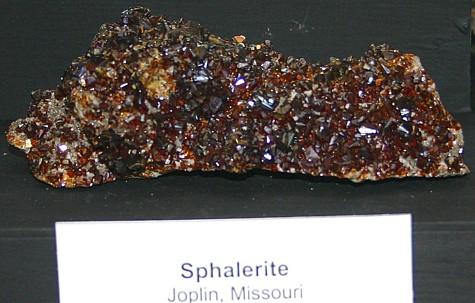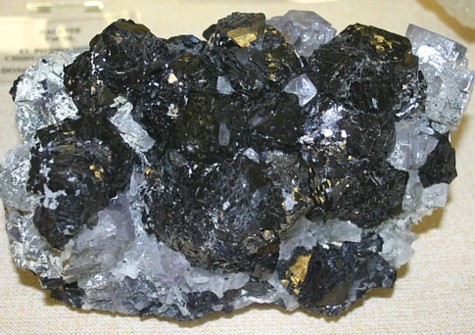|
.
Sphalerite Mineral Facts:
Chemical Formula: ZnS
- The Mineral is 67% Zinc by weight when pure.
Colors:
Usually Black, Brown or some shade
of Red, may be yellowish or
green.
Its streak is
brownish, yellow or white. Color is white when absolutely pure, and
green when nearly so, the color darkening with increase in the amount of
iron present. . The yellow masses look very much like lumps of rosin.
Hardness:
3.5 to 4
Density: 4 to 4.1
Density varies somewhat depending
on formation and impurities.
Cleavage:
Sphalerite has a
perfect dodecahedral cleavage parallel to {011}. Its fracture is
conchoidal.
Crystallography: Isometric, Tetrahedral
The tetrahedron, dodecahedron and cube are all common forms, but the
crystals are frequently highly complex and usually distorted or in
rounded forms. They are often twinned.
Commonly found in
massive cleavable forms, coarse to fine granular, also compact and
botryoidal. Also in rounded crystal masses.
Luster:.
Adamantine to Resinous to
Submetallic, transparent to nearly opaque.
Optics:
(Refractive Index)
2.369 for yellow light when
transparent (a rather High RI) |
 |
Composition,
Structure and Associated Minerals:
Sphalerite
is the most
important ore of zinc, and an extremely common mineral, especially as a
constituent of metallic veins. Found widely distributed, but chiefly in
veins and irregular bodies in limestone rocks. Associated with
pyrite,
galena, marcasite,
chalcopyrite, smithsonite,
calcite, dolomite, siderite,
etc. It may carry silver or gold.
It is one of the very
important zinc ores and one of the most interesting minerals from a
crystallographic standpoint, occurs in amorphous and crystalline masses and
in handsome crystals and crystal groups. Botryoidal and other imitative
masses are common.
From a compact mass of the mineral a fairly good
dodecahedron
may sometimes be split. When
pure the mineral is transparent and colorless.
Pure white sphalerite
consists of 67 per cent of Zn and 23 per cent of sulfur.
However it almost always
contains at least a small percentage of iron replacing the zinc, but the
amount of iron may rise as high as 15 to 18 per cent.
The colored varieties
usually contain traces of silver, iron, cadmium,
mercury,
manganese and other metals.
Sometimes the proportion of the impurities is so large that the mineral
containing them is regarded as a distinct variety. Argentiferous zinc is the
source of a considerable quantity of silver.
The mineral is a nonconductor of electricity.
By
the effects of
weathering and oxidation, sphalerite changes into the sulfate of zinc, and
by other processes into the silicate of zinc, calamine, or the carbonates,
smithsonite and hydrozincite.
Identification and Diagnostics
Sphalerite
is difficultly fusible, and when powdered always yields tests for
sulfur under proper treatment. On charcoal it volatilizes slowly,
coating the coal with a yellow sublimate when hot, turning white on
cooling. When moistened with a dilute solution of cobalt nitrate and
heated in the reducing flame, the white coating of ZnO turns green. The
mineral dissolves in hydrochloric acid, yielding sulphuretted hydrogen.
Infusible with pure zinc sulfide to difficultly fusible with increase
in amount of iron. Gives odor of sulfur dioxide when heated on charcoal
or in 0. T. Decomposed in powder by warm hydrochloric acid with
evolution of hydrogen sulfide gas, which may be detected by its
disagreeable odor. When heated on charcoal gives a coating of zinc oxide
(yellow when hot, white when cold) which is nonvolatile in oxidizing
flame. Recognized usually by its striking resinous luster and perfect
cleavage. The dark varieties (black jack) can be told by noting that a
knife scratch leaves a reddish brown streak.
|
 . . |
|
Occurrence,
Localities and Origins:
Sphalerite occurs disseminated thorough limestone, in streaks and irregular
masses in the same rock, and in veins cutting crystalline and sedimentary
rocks. It is often associated with galena. The material in the veins is
often crystallized. Here it is associated with chalcopyrite (CuFeS2),
fluorite (CaF2),
barite (BaSO4), siderite (FeCOs), and silver ores.
When in veins it
is in some cases the result of ascending hot waters and in other cases the
product of percolating meteoric water. Much of the disseminated ore is a
metamorphic contact deposit.
Crystallized
sphalerite is found abundantly at Alston Moor, Cumberland, England; at
various places in Saxony; in
fine crystals at
Binnenthal, Switzerland; at Broken Hill, N. S. Wales, and in nearly all
localities for galena.
It is also found at Schemnitz and other localities in
the gold and silver-mining districts of Hungary.
Handsome, transparent, cleavable masses are brought from Pilos de Europa,
Santander, Spain. Stalactites are abundant near Galena, Illinois. The
principal deposits of economic importance in America are those in Iowa,
Wisconsin, Missouri and Kansas, where the sphalerite is associated with
other zinc compounds and with galena forming lodes in limestone, and at the
silver and gold mines of Colorado, Idaho and Montana. Large deposits are
found in the United States in Missouri, Kansas, Arkansas, Wisconsin, Iowa,
Illinois, Colorado.
The chief US locality for its production is the Joplin
District in southwestern Missouri. Found in large quantities in connection
with the lead-silver deposits of Leadville, Colorado.
The name old name for sphalerite,
blende, is taken from the German, blind or deceptive, because while often
resembling galena it yielded no lead. Sphalerite, for the same reason, is
derived from a Greek word meaning treacherous. Sphalerite is the most
important ore of zinc. The chief uses for metallic zinc are in galvanizing
iron, making brass, (an alloy of copper and zinc), in electric batteries,
and as sheet zinc. Zinc oxide, or zinc white, is used extensively for making
paint. Zinc chloride is used as a preservative for wood. Zinc sulfate is
used in dyeing and in medicine. Sphalerite also serves as the most important
source of cadmium, which is recovered as a byproduct of the zinc smelting
process. In rare cases when the mineral is transparent, sphalerite has been
cut as a gemstone, showing off its very high refractive index.
Return to the
Mineral Collectors Information Page |
|



